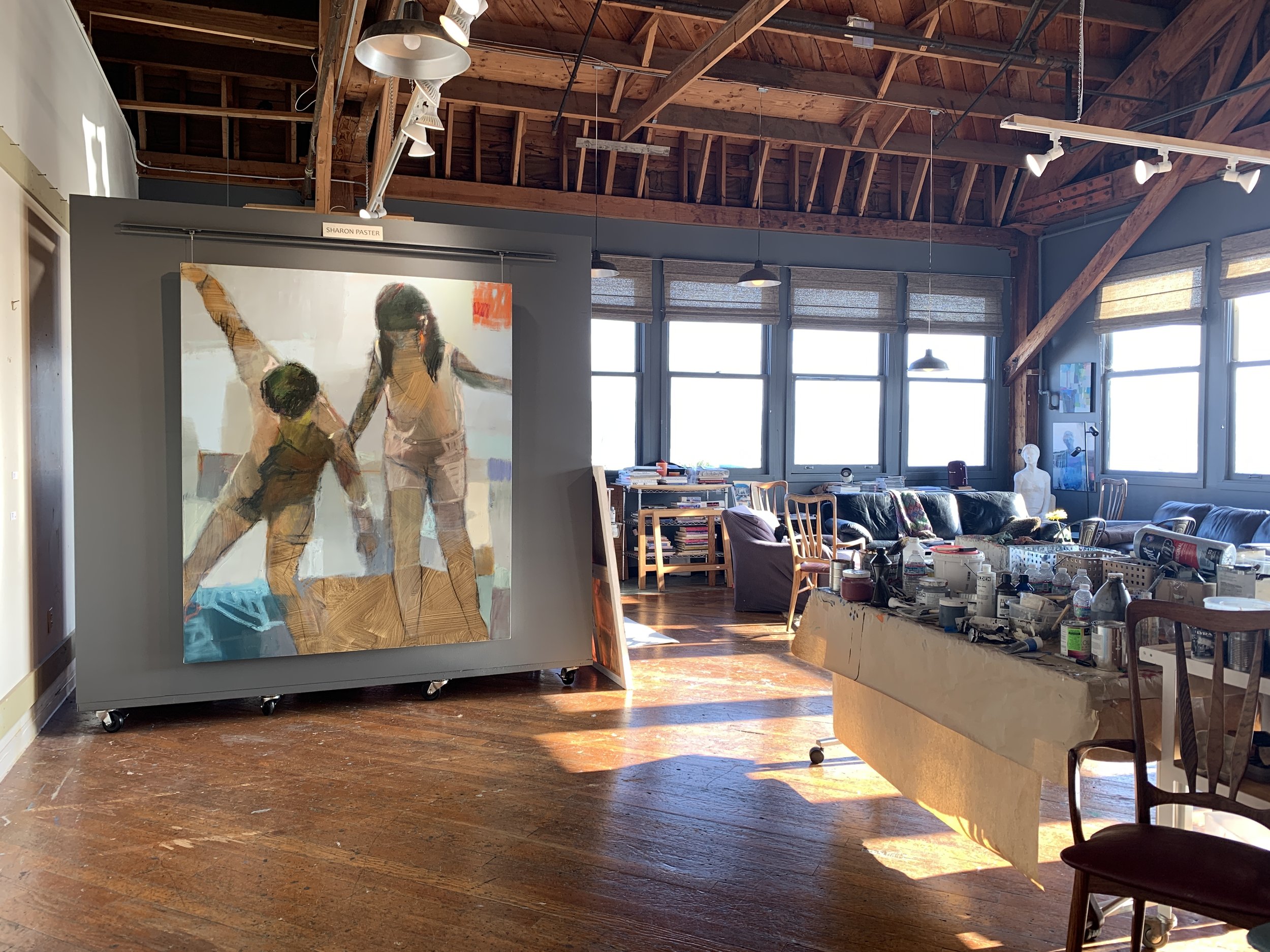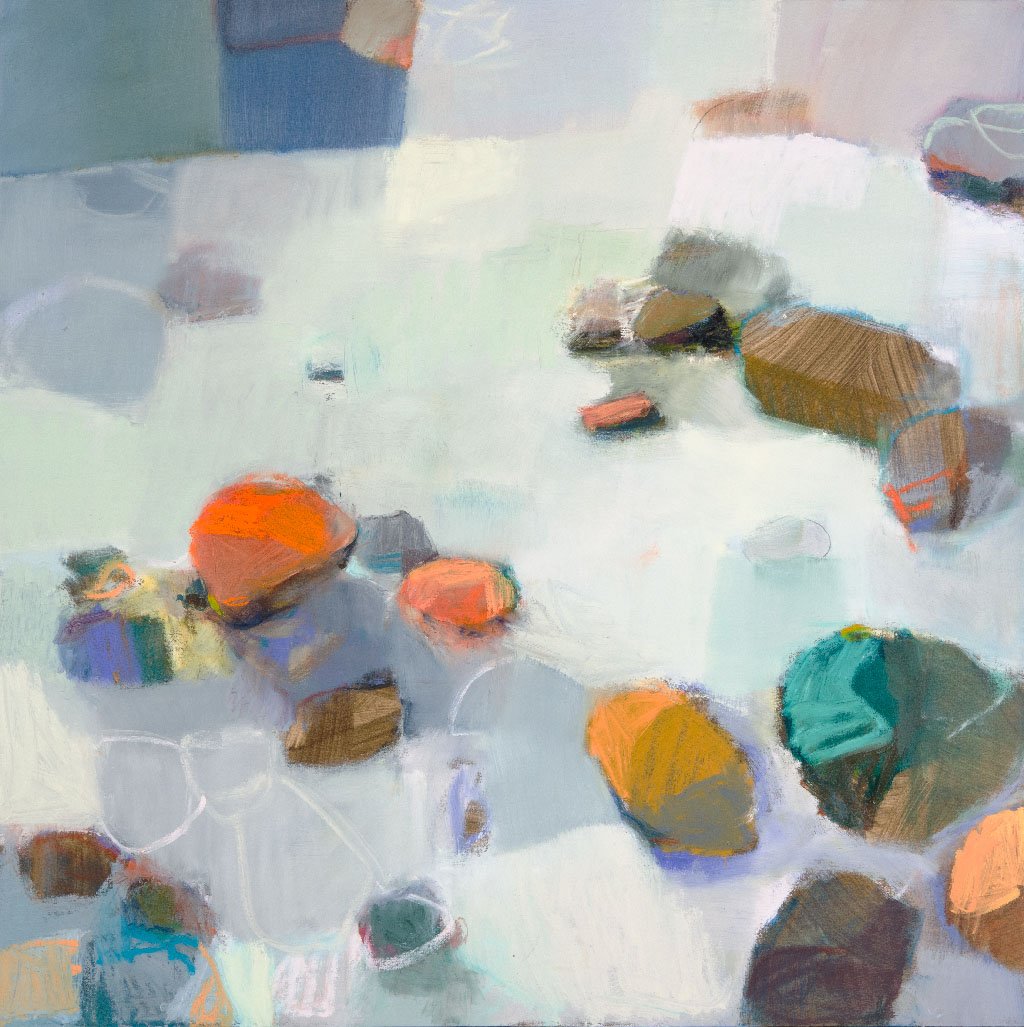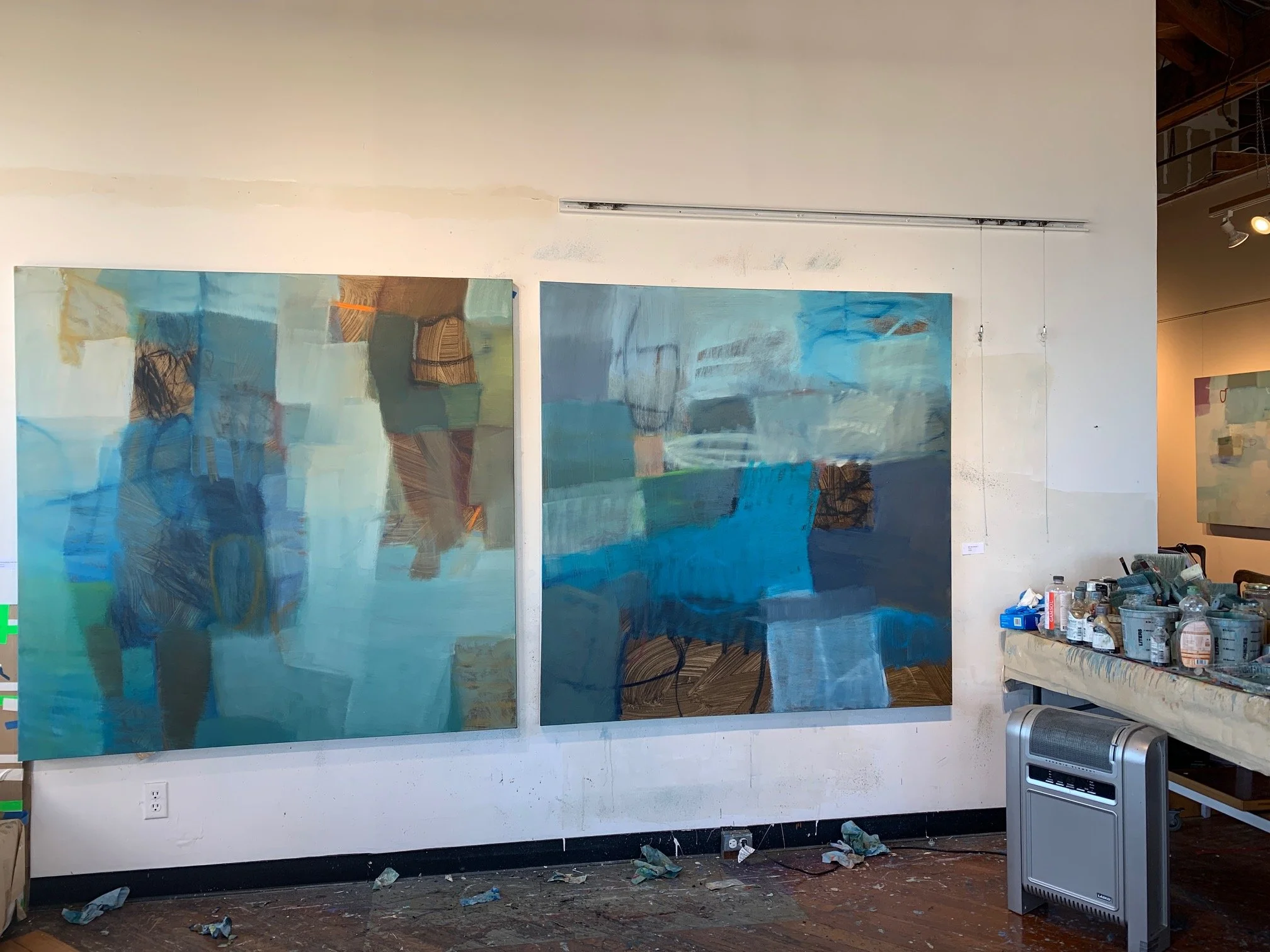Artist Spotlight: Sharon Paster
Bay Area artist Sharon Paster’s work reflects her attraction to the energy around her, “the force of a pounding surf, the motion of cars on a highway, the blink of an eye, the way objects in space talk to one another.” Her colorful oil paintings are an effort to suspend time, capturing movement and change.
Sharon has exhibited in numerous group and solo shows—including San Francisco’s de Young Museum, the Marin Museum of Contemporary Art, the San Jose Institute of Contemporary Art and the Sonoma Valley Museum of Art. Her work has been included in Art of Northern California, the Serena & Lily Catalog, Luxe Magazine, Marin Magazine and San Francisco Magazine. She is on the ICB (Industrial Center Building) Art Association’s Board of Directors and her work is represented by a number of galleries in the Bay Area, as well as Boston, Tampa, and South Florida.
Tell us a little bit about yourself. You began painting early, and majored in art, but then moved on to a career in high tech marketing communications before returning to painting. What drew you back?
I began volunteering in the kindergarten art classes to stay involved with my kids, who are both now in their thirties. One day, I also happened to walk by the San Francisco Art Institute where the windows were open at the sidewalk’s basement level. I think it was the smell of turpentine that finally did it.
I stopped painting after college because I was very dissatisfied with my work. The smell and the lack of inhibition in children were what made me realize that art-making could be fun, it didn’t have to be “great.” So, I went back to the local community college in Marin to take classes. There I found so many like-minded people—professional artists as well as non-professionals—and just became part of the tribe. I stayed there taking courses in painting, drawing and sculpture with fantastic teachers for so many years, I got kicked out.
Sharon Paster, Intermission, 36” x 36”, oil on canvas.
How does life in northern California contribute to the themes or energy present in your work?
Not to make anyone feel bad about where they live, but the Bay Area is one of the most creative places in the world. There are tons of artists, writers, musicians, and designers of all stripes here. People are very open-minded. The weather is relatively mild, the coastal scenery is spectacular, and outdoor activity is part of the culture.
When I began painting again after a long hiatus, one of my first subjects was a pair of black shoes positioned in various conversational ways. I noticed the Marin hillsides here offered the same subject matter, with little conversations happening between bushes and various densities of shrubs. After a while, when I tired of the landscape horizon, I looked down and found the same energy between rocks— particularly between rocks at the water’s edge—as well as the energy between layers of the water itself. I started working more abstractly, going back and forth between representation and abstraction, and trying to get them to merge on various levels.
Sharon Paster, Diving In, 72” x 60”, oil on canvas.
Have you always worked in oil?
I began private painting lessons in oil at the age of 14. My grandfather painted in his Bronx basement in New York and I remember holding a loaded brush at a ridiculously early age, but we moved to Southern California when I was 5 and that was the end of that.
I was an oil painter in college in New England, but of course took printmaking and sculpture classes as well, and played with oil pastels all the time, drawing these cartoony faces and layering the colors. (I still can’t find one lipstick that works for me. I layer three at the same time.) I never learned how to work with acrylics. Since I loved the feel and smell of oils, I wasn’t motivated to learn water-based media at all. And watercolor just killed me, probably because I couldn’t control the layering.
What does your studio look like? What is a typical studio day like?
I have absolutely the best studio, in the best artist building in the Bay Area—what else can I say? My first studio was behind my house in Marin, and it was fine, especially when I was still connected with the college community.
When we were selling the house I knew I had to find space, and I was aware of the ICB Building in Sausalito, with about 100 working artist studios. I and was fortunate to find a closet-sized studio as a subtenant of Katy Kuhn, a fantastic and generous abstract artist.
My space eventually grew by knocking down a wall, and then a few years ago I got a chance to take over a corner studio on the top 3rd floor, overlooking the water. It’s quite large and the view is inspirational, but it took me awhile to get used to being in a huge space with so much light. For about 6 months, I couldn’t judge my work, everything was so foreign. Now I just try to focus on the wall where I work, and look out the windows only when I’m at a loss for color ideas or spatial cues.
In addition to working wall space, I have a gallery to hang paintings and other areas for storage, and use the studio for crits and artist meetings.
Studio view.
Sharon Paster, Eight Ball, 60” x 60”, oil on canvas.
On a typical day when I’m not traveling, I exercise in the morning, cross off things on my to-do list, and get to the studio around 11am. My prior studios never had a comfortable place to sit, so focusing for 2 - 3 hours worked great. Now I can stay 4 - 5 hours without losing it.
I’m also co-president of the ICB Artists Association (after being on the board for 6 years), which has over 80 members in the building, so I like to meet with other artists, and socialize or help plan activities, to foster more learning opportunities for all of us. So, I guess I’d have to say my favorite thing about my studio is a toss-up between the space and the amazing people I’m surrounded with.
How has your work shifted over the years? What interests you now?
I still go back and forth between representation and abstraction, looking for that sweet spot where I can offer a hook to the viewer without totally defining what they’re seeing. A recent studio visitor asked me what I’m focusing on, and I responded by saying “rocks, landscapes, abstracts, and now trying to figure out the figure,” so I’m clearly all over the place.
For now, the figure is just too personal for me, and it’s hard for me to treat it abstractly. So that’s my biggest struggle right now. But I definitely bounce from one subject to another. The only constant is that I use the same tools all the time. And I always try to pay attention to the feeling of air and movement within space, which are so important to my work.
Sharon Paster, Dreaming 2, 60” x 60” (framed), oil on canvas.
Blending color on a painting.
Why R&F Pigment Sticks®?
Many years ago, I started using linear elements (accenting areas with charcoal) in my paintings. When I wanted to make those lines in color, I used oil pastel. The oil pastel was fairly permanent, so you really can’t change your mind. Once it’s on the canvas, it just stays there.
I stumbled upon R&F Pigment Sticks® at my local art supply store. I figured they’d be just like oil pastels, only bigger. But when I went to rub out a line, I realized they were more malleable and paint-like, almost like lipstick. This was a huge discovery for me. I bought a bunch of colors and realized I could layer them like oil pastels, but then blend them with a brush if I wanted.
Work in progress.
Since I hated mixing paint on a palette and wasting it when it wasn’t right, and I hated cleanup even more, this became my go-to way of operating. I can do everything with them: glaze, make marks, blend colors… you name it, the oil sticks can do it. It just depends on the pressure of your hand, the brush or towels you use, and the medium you put on the brush. I don’t use a palette anymore.
Do you have any go-to colors? Ones you couldn't paint without?
I go through countless large sticks of the light and pale colors, which I blend on the canvas to make up most of my “background” areas. But I couldn’t live without my go-to accent marks, for which I am completely indebted to the orange family. I also can’t live without any of the blues. I’m learning to love Turkey Umber Greenish. This question is too hard.
Sharon Paster, Revelation, 48” x 72”, oil on canvas.
To see more of Sharon’s work, sharonpasterart.com.











